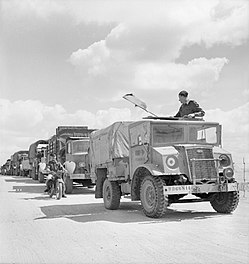Canadian Military Pattern truck
| Ford F15 | |
|---|---|

A Ford F15 (4x2) leading a RAF convoy in North Africa
|
|
| Type | 3 ton 4x4 Cargo |
| Place of origin | General Motors of Canada Limited Ford and Chrysler Canada |
| Service history | |
| In service | From 1940 |
| Wars | World War II |
| Production history | |
| Designer | Chevrolet Canada and Ford |
| Designed | 1936–1940 |
| Manufacturer | Chevrolet in Oshawa and Ford |
| Produced | 1940–1945 |
| No. built | 500,000+ Service Flag 3298 for Employees of Canada's Armed Forces |
| Specifications | |
| Weight | 7,875 lb (3,572 kg) |
| Length | 204 in (5.18 m) |
| Width | 84 in (2.13 m) |
| Height | 116 in (2.95 m) |
|
|
|
| Engine |
Chevrolet GM 216 239 cu in (3.9 L) gas V8 95 hp (71 kW) |
| Suspension | Wheel 4x4 |
| Speed | 50 mph (80 km/h) |
Chevrolet GM 216
216 cu in (3.5 L) gas I6
85 hp (63 kW)
The Canadian Military Pattern (CMP) truck was a class of military truck - of various forms - made in large numbers in Canada during World War II to British Army specifications for use in the armies of the British Commonwealth allies. Standard designs were drawn up just before the beginning of the war.
CMP trucks were also sent to the Soviet Union following the Nazi invasion, as part of Canada's Gift and Mutual Aid program to the Allies. During the War CMP trucks saw service around the world in the North African Campaign, the Allied invasion of Sicily, the Italian Campaign, the Soviet Front, the Burma Campaign, the Battle of the Philippines (1941–42), the liberation of Northwest Europe, and the Western Allied invasion of Germany. CMP trucks also saw service in post-war conflicts in Indonesia, French Indochina, and the Portuguese colonies in Africa.
The rise to power in Germany of Hitler and the Nazi party in 1933 led to discussions in the mid-1930s between the British War Office and the Canadian Army concerning the possible production of military vehicles in Canada. During the First World War Canadian land forces had participated as a corps in the British Army. In any future conflict it was assumed that Canadian forces would again be tightly integrated with those of the Mother Country, and so it would be essential that Canadian-manufactured equipment be compatible with British standards and specifications.
...
Wikipedia
